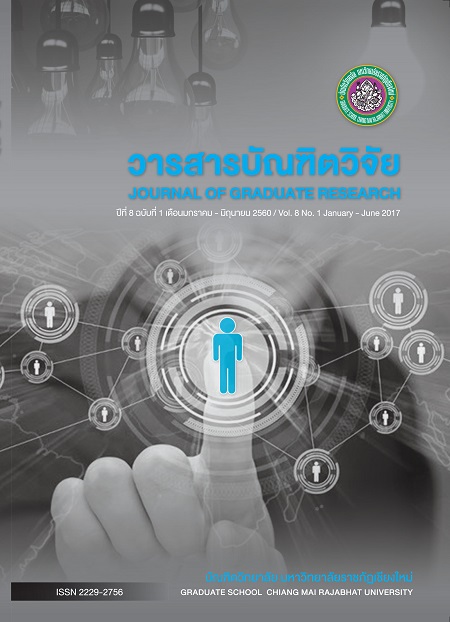การจัดการเรียนรู้เพื่อพัฒนาผลสัมฤทธิ์ทางการเรียนคณิตศาสตร์ เรื่องโจทย์ปัญหาการบวกและการลบโดยใช้กระบวนการแก้โจทย์ปัญหาของโพลยา สำหรับนักเรียนชั้นประถมศึกษาปีที่ 2
Main Article Content
Abstract
การวิจัยครั้งนี้ มีวัตถุประสงค์ เพื่อสร้างและหาประสิทธิภาพของแผนการจัดการเรียนรู้คณิตศาสตร์ เรื่อง โจทย์ปัญหาการบวกและการลบ เพื่อเปรียบเทียบผลสัมฤทธิ์ทางการเรียนคณิตศาสตร์ ก่อนและหลังเรียน การแก้โจทย์ปัญหาโดยใช้กระบวนการแก้โจทย์ปัญหาของโพลยา และเพื่อศึกษาความพึงพอใจของนักเรียนที่มีต่อการเรียนรู้ คณิตศาสตร์ โดยใช้กระบวนการแก้โจทย์ปัญหาของโพลยา ประชากรที่ใช้ในการศึกษาครั้งนี้คือ นักเรียนชั้นประถมศึกษาปีที่ 2 โรงเรียนอนุบาลบ้านพระเนตร ตำบลต้า อำเภอขุนตาล จังหวัดเชียงราย ในภาคเรียนที่ 2 ปีการศึกษา 2557 จำนวน 22 คน เครื่องมือที่ใช้ในการเก็บรวบรวมข้อมูลประกอบด้วย แผนการจัดการเรียนรู้ กลุ่มสาระการเรียนรู้คณิตศาสตร์ เรื่องโจทย์ปัญหาการบวกและการลบโดยใช้กระบวนการแก้โจทย์ปัญหาของโพลยา จำนวน 9 แผน จำนวนแบบฝึกทักษะ 9 แบบฝึก และแบบทดสอบวัดผลสัมฤทธิ์ทางการเรียนแบบปรนัย จำนวน 20 ข้อ ที่มีค่าความเชื่อมั่น 0.5327และแบบสอบถามความพึงพอใจต่อการจัดการเรียนรู้คณิตศาสตร์ เรื่องโจทย์ปัญหาการบวกการลบโดยใช้กระบวนการแก้โจทย์ปัญหาของโพลยา นักเรียนชั้นประถมศึกษาปีที่ 2 ที่ผ่านการตรวจสอบจากผู้เชี่ยวชาญ จำนวน 3 ท่าน
ผลการวิจัย พบว่า
1. แผนการจัดการเรียนรู้กลุ่มสาระการเรียนรู้คณิตศาสตร์ เรื่องโจทย์ปัญหาการบวกและการลบโดยใช้กระบวนการแก้โจทย์ปัญหาของโพลยา โดยรวมมีความเหมาะสมและมีประสิทธิภาพ 77.02/77.05 ซึ่งสูงกว่าเกณฑ์ 75/75 ที่ตั้งไว้
2. ผลสัมฤทธิ์ทางการเรียนรู้กลุ่มสาระการเรียนรู้คณิตศาสตร์ เรื่องโจทย์ปัญหาการบวก และการลบโดยใช้กระบวนการแก้โจทย์ปัญหาของโพลยา พบว่า นักเรียนมีคะแนนหลังเรียนเฉลี่ย เท่ากับ 15.4 คิดเป็นร้อยละ 77.05 มีคะแนนพัฒนาการเพิ่มขึ้นร้อยละ 24.32
3. ความพึงพอใจของนักเรียนที่มีต ่อการเรียนรู ้กลุ ่มสาระการเรียนรู ้คณิตศาสตร ์ เรื่อง โจทย์ปัญหาการบวกและการลบโดยใช้กระบวนการแก้โจทย์ปัญหาของโพลยา พบว่า โดยรวมมี ความพึงพอใจอยู่ในระดับมาก
THE LEARNING MANAGEMENT TO DEVELOP LEARNING ACHIEVEMENT IN MATHEMATICS ENTITLE “ADDITION AND SUBTRACTION” BY USING POLYA’S PROBLEM SOLVING PROCESS FOR PRATHOMSUKSA 2 STUDENTS
The objectives of this research were to construct and find out the efficiency of Mathematics learning lesson on “Addition and Subtraction”, to compare the learning achievement before and after learning by using Polya’s problem solving process and to examine the satisfaction of students towards Mathematics learning by using Polya’s problem solving process. The population of this study was 22 PrathomSuksa 2 students at Anuban Ban Pranet School in Khun Tan District, Chiang Rai province in the second semester of the academic year 2014. The research instruments were nine learning plans in Mathematics strand entitle “Addition and Subtraction” by using Polya’s problem solving process, ten exercises, a 20 item learning achievement test in objective type with the reliability of 0.4133, and a questionnaire on the satisfaction of PrathomSuksa 2 students towards Mathematics lesson on “Addition and Subtraction” by using Polya’s problem solving process which was approved by three experts.
The results of the study were found as follows;
1. The appropriateness and the efficiency of learning plan in Mathematics lesson on “Addition and Subtraction” by using Polya’s problem solving process, in general, was 77.02/77.05 which was higher than the criteria set at 75/75.
2. The learning achievement in Mathematics lesson on “Addition and Subtraction” by using Polya’s problem solving process appeared that the mean of students’ score after learning was 15.41 or 77.05% which was higher than before learning and the percentage of progress score was 24.32.
3. The students’ overall satisfaction towards Mathematics lesson on “Addition and Subtraction” by using Polya’s problem solving process was at the high level.


